Charles arrived at Bentley Hall around midnight on Tuesday, September 9. The Lane family was not Catholic, so there was no priest hole, so he likely spent the night in servants’ quarters, or possibly in the main house.
 |
Bentley Hall in 1686. Summer house on the left,
banqueting house and stables on the right. |
 |
Miniature of Col. John Lane and
pouncet box given to Jane Lane by Charles |
The Lanes of Bentley Hall became involved in the king’s escape because Jane Lane, who was probably about 25 years old at the time, had a pass allowing her and a serving man to travel to visit a friend at Abbots Leigh, near Bristol.
The original plan had been that Charles would make his way to Wales and find a ship from there, and that his friend Lord Wilmot would ride with Jane, pretending to be her servant, and he would set sail from Bristol. But now it was the king himself who would be riding with Jane, in the persona of Will Jackson, the son of a tenant farmer of the Lanes.
 |
Jane Lane about 1652.
This portrait hangs at Mosely Old Hall and is used
by gracious permission of the National Trust. |
On the face of it, the plan seemed wildly implausible. Charles was Public Enemy Number One to Cromwell’s government. He was six feet two inches and dark complexioned – not at all typical looking – there were soldiers looking for him everywhere, and there were notices posted in every village in England describing him – and noting the likelihood that he would be in disguise – and offering a vast reward for turning him in. Moreover, his travels up to this point, only a few miles at a time, had taken place secretly and at night. Now he would be riding a hundred miles in broad daylight on publicly traveled roads.
 |
| Stables at Bentley Hall, about 1908 |
Sometime before dawn on September 10, Charles bathed, shaved, trimmed his hair more neatly, and put on the Sunday-best grey broadcloth suit of clothes that a tenant farmer’s son might own. He also got a pair of shoes that fit him.
 |
Stables at Bentley, about 1908, from The Flight of the King.
It was here that Charles's and Lord Wilmot's horses were hidden
while Wilmot was at Moseley, which was close to the road. |
In the morning, the party was ready to set out. Jane Lane was to ride with Charles, and her cousin Henry Lascelles, a Royalist soldier, was going along for extra protection. But a last-minute complication was that Jane’s sister Withy and her husband John Petres decided to ride with Jane for the first part of her journey, making their way home to Buckinghamshire. And they didn’t know that the servant accompanying Jane was actually the fugitive king.
 |
An old print showing Jane Lane, riding pillion
behind Charles, and Henry Lascelles |
 |
| Hunting and hawking |
Jane’s brother John and Lord Wilmot were to set out shortly after the first party, ostensibly going to visit John’s friend Sir Clement Fisher (and Jane's future husband) at Packington in Warwickshire for some hunting. That way they could catch up to the king and his companions but stay at a distance, so they could have the royal party within sight for a few hours. Throughout the king’s travels, Lord Wilmot, though he was a wanted man, disdained to wear a disguise, saying it would “look frightfully.” A hawk on his wrist was as much of a costume as he was willing to put on, which at least in this instance was suitable.
 |
Packingon Old Hall
Jane's home after she married Sir Clement Fisher in 1663. |
 |
Packington Old Hall, Meriden, Warwickshire, where Wilmot
and John Lane went to see Jane's future husband, Sir Clement Fisher.
|
Jane Lane was to ride pillion behind Charles. This was a common mode of transportation for centuries – the man riding astride the horse and controlling it, his female passenger behind him, seated facing sideways on a pillion, a pad or saddle which was attached to the rear of the saddle and secured under the horse’s tail with a crupper, and her feet on a little shelf called a planchette hanging down to one side.
 |
Steve and Jean Emmit. She is riding pillion.
As you can see, the lady has to snuggle up to the man. Sexy! Photo provided by Natalie Wooldridge. |
The first test of the king’s disguise came immediately. He offered his arm to Jane to help her onto the horse, but he gave her the wrong arm. Her mother asked her brother scornfully what simpleton he had got to accompany Jane that didn’t know how to help a lady mount.
 |
Photos of pillions from In the Saddle,
provided by Mike Glasson of the Walsall Leather Museum |
The sun rose on a clear and beautiful day, and Charles must have felt more hopeful than he had since before the battle. Jane, Henry, and the king were to spend the first night in Long Marston, at the home of the Lanes’ cousins John and Amy Tomes. They rode southwest from Bentley, through Darlaston, Pleck and Quinton. But less than two hours after they had left, Jane’s horse threw a shoe. This was the equestrian equivalent of a flat tire – it simply wasn’t possible to ride very far without having the horse re-shod.
Fortunately, not far ahead lay the village of Bromsgrove, and a blacksmith. (During my research trip in 2009 my friend Alice and I were directed to the Black Cross as being the inn to which the smithy was attached).
 |
Alice in front of the Black Cross, the inn
at Bromsgrove
|
 |
| The old smithy at the Black Cross at Bromsgrove |
As Charles was posing as a servant, it was up to him to take the horse to be attended to, which he almost certainly had never done, and here he was to come face to face for the first time with people who might recognize him. The Penderels had coached him so that he moved more like a countryman than a king, and, as he was apparently a gifted mimic, he could imitate the local accent. He decided to see how well he could so, and described the incident to Samuel Pepys many years later.
 |
| Blacksmith's shop; early 20th century |
"As I was holding my Horses Foot, I asked the smyth What Newes? He told me that there was noe newes that he knew of since the good newes of the beateing of the Rogues, the Scots. I asked him whether there was none of the English taken that joined with the Scots. He answered that he did not heere that that Rogue Charles Steward was taken. I told him that if that Rogue were taken he deserved to be hanged more then all the rest for bringing in the Scots. Upon which he said that I spoake like an honest man, and soe we parted.”
 |
Jane Lane riding pillion behind Charles
from a painting at the Houses of Parliament |
The party resumed its journey without event until about a mile before they got to Stratford-Upon-Avon, when an old woman in the fields by the side of the road called out to Charles, “Don’t you see that troop of cavalry ahead, Master?” Did she know who he was? He didn’t know. The worse problem was that there was a troop of horse stopped about half a mile ahead, “the Horses eateing some grass by the wayside, staying there … while their Muster-Maister was providing their Quarters. Mrs. Lanes sisters Husband … seeing this Troop of Horse just in our way, sayd, that for his part he would not goe by them, for he had been once or twice beaten by some of the Parliament Soldiers, and he would not Runn the venture again. I heareing him say soe begg’d Mrs. Lane softly in her Eare, that we might not turne back but goe on, for that the Enemy would certainly send after us to enquire who we were, if they should see us turne. But all she could say in the world would not doe, but her Brother-in-law turned quite round and went into Stradford another way, the troop of Horse being there just getting on Horse-back.” The king’s party had no choice this time but to ride among the cavalry blocking the narrow road, but this was the first of many times when Charles passed right under the noses of soldiers who were looking for him but failed to recognize him.
 |
17th century cavalryman.
Photo from Xerones's photostream on Flickr. |
 |
| The home of Jane's cousins John and Amy Tomes |
Once over the River Avon, Jane’s sister and brother-in-law branched off toward their home, so that now Charles was accompanied only by Jane Lane and Henry Lascelles. They reached Long Marston, a little southwest of Stratford-Upon-Avon, without further problems, but at the home of Jane’s cousin, Charles had another adventure in everyday living. As a servant, his place was in the kitchen. The cook asked him to wind up the jack, a mechanical device used to turn a spit over a fire on which meat was roasted. He grasped the handle but turned it the wrong way, prompting the cook to snap, “What countryman are you that you know not how to wind up a jack?” Charles, thinking on his feet, said that he was a poor tenant farmer’s son, and that his family didn’t often eat roast meat, and when they did, they didn’t use a jack.
 |
| Fireplace in the Tomes house, Long Marston |
 |
| Jack in the kitchen at Long Marston |
Once more the king had successfully passed as someone far different than he was, and they were a third of the way to Bristol.
 |
Tomes house in about 1908
sketch from The Flight of the King |
 |
Chipping Camden
old stone marketplace stall
October 2009 |
The next day was mercifully less eventful. Charles, Jane, and Henry Lascelles travelled on, south and west, through Chipping Camden and Stow-on-the-Wold, reaching Cirencester by nightfall. They stayed at the Crown Inn just off the marketplace, Charles sharing a bedroom with Henry, who of course gave the king the big bed and took the servant’s pallet for himself.
 |
| Cirencester in an old print |
 |
Fire iron in Crown Inn, Cirencester
with royal coat of arms, probably dating from 17th century |
When Alice and I were following in Jane’s and Charles’s footsteps in the autumn of 2009, we had a couple of funny incidents involving the Crown Inn. We passed through the town on our way to Bristol, stopping only for a short walk around the market area. I popped in to a pub to use the loo, and we were on our way.
 |
| Cirencester marketplace, October 2009 |
Over the next day or two, I reread some of the accounts of the trip and noted that the Crown Inn was where our travelers had stayed. When we went back through Cirencester, we wanted to find the Crown – and discovered that it was the very place I’d ducked into a couple of evenings earlier. This time we stopped and had a meal and a pint there.
 |
| Interior of Crown Inn, Cirencester |
I told the bar man about my book, and following Jane and Charles, and he proudly said, “That’s the window he jumped out of.” Baffled, I asked why Charles should have jumped out a window. I forget the exact answer, but I think it had to do with Bonnie Prince Charlie, who probably never stayed there. But a good story, nonetheless.
 |
The Crown, Cirencester
Photo by Alice Northgreaves |
 |
| Wall of church, Cirencester |
 |
| Church wall, Cirencester |
 |
Church at Cirencester
|
 |
Wheelbarrow outside church at Cirencester.
Note the stone cobbling of the marketplace.
|



































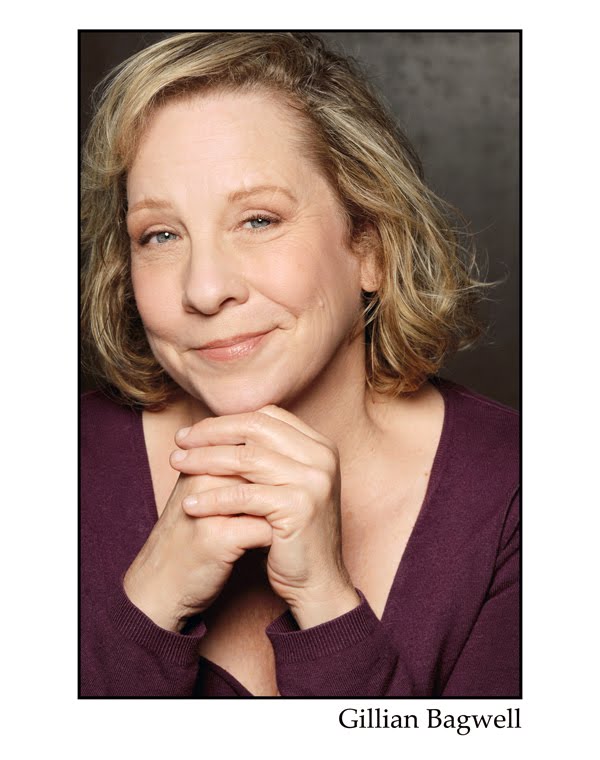

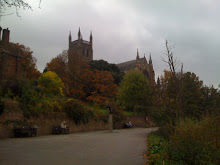
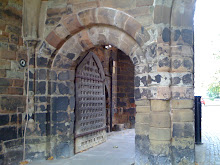



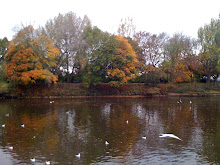
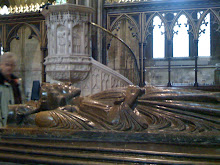
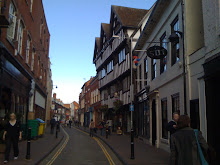


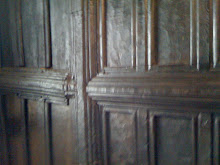






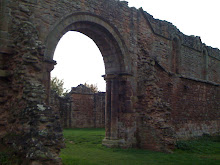




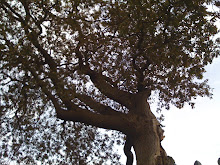





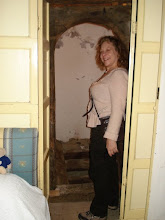
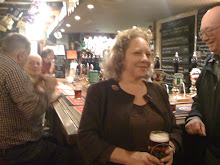
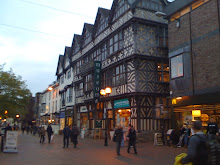
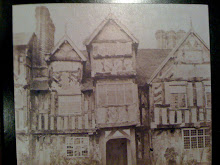


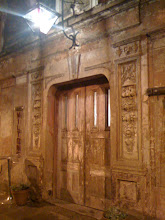
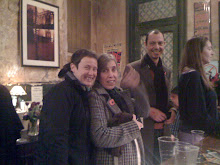


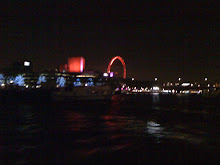


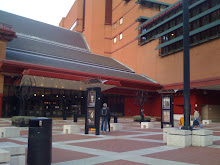


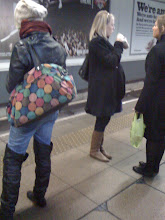


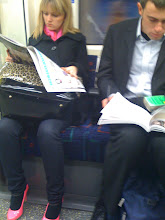
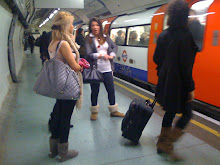

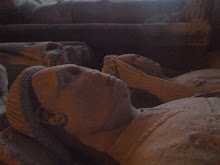
Rather wonderful site, with excellent research and a refreshing approach to what many would see as dusty old history. Much enjoyed and appreciated!.
ReplyDeleteI am related to Mistress Jane Fisher nee Lane and Colonel John Lane and congratulate you on the depth of knowledge It is a pleasure to follow your progress. Thank you Michael John Lane
ReplyDeleteAccording to British-History Buildings King Charles 11 stayed at Chaceley Hall in 1651 When Sir Joseph Lane was in residence. However, I cannot find any other evidence to this event. Maps of the journey to Shoreham do not include passing through the village of Chaceley. Is this perhaps to attract the visitors when the Hall is open to the public.
ReplyDeleteI have since established that Chaceley Hall Chaceley is now in private hands and is not open to the public. There is still no sign of a Sir Joseph Lane in Chaceley in 1651.
ReplyDeleteThanks and that i have a super offer you: How Long Renovate House custom home remodeling
ReplyDeleteThis sounds like a very daring plan.
ReplyDelete